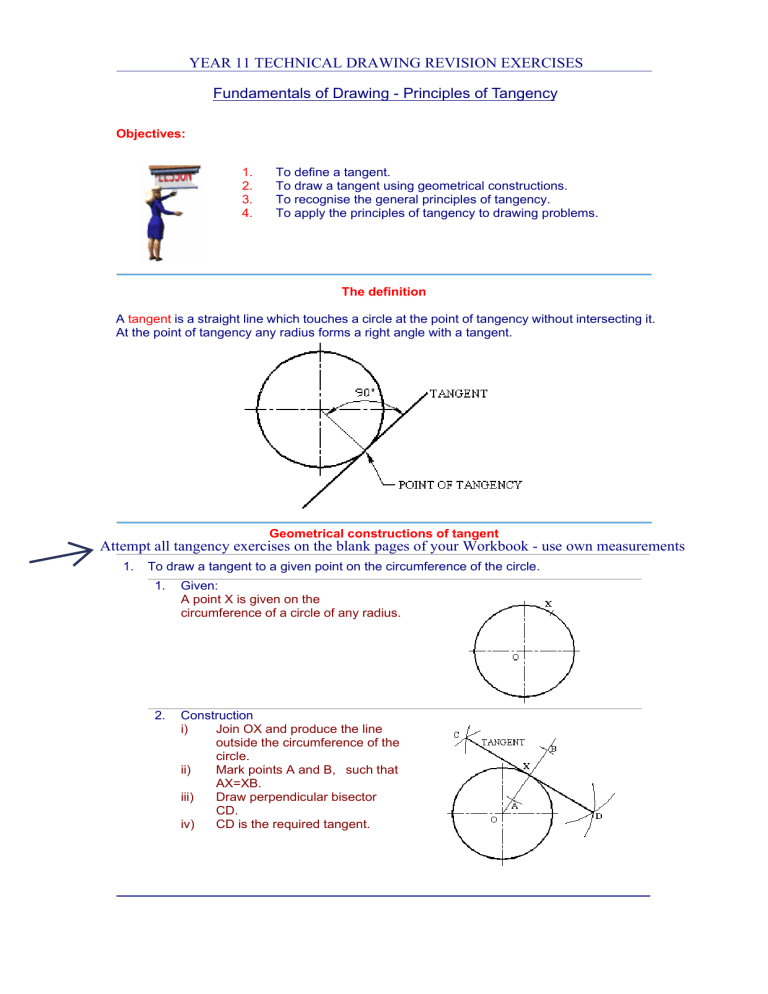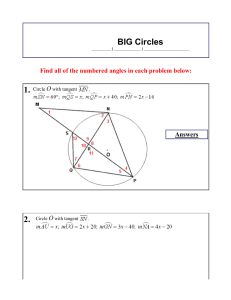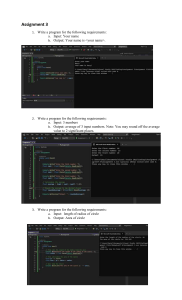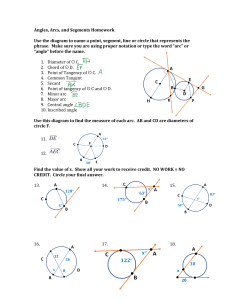
YEAR 11 TECHNICAL DRAWING REVISION EXERCISES Fundamentals of Drawing - Principles of Tangency Objectives: 1. 2. 3. 4. To define a tangent. To draw a tangent using geometrical constructions. To recognise the general principles of tangency. To apply the principles of tangency to drawing problems. The definition A tangent is a straight line which touches a circle at the point of tangency without intersecting it. At the point of tangency any radius forms a right angle with a tangent. Geometrical constructions of tangent Attempt all tangency exercises on the blank pages of your Workbook - use own measurements 1. To draw a tangent to a given point on the circumference of the circle. 1. Given: A point X is given on the circumference of a circle of any radius. 2. Construction i) Join OX and produce the line outside the circumference of the circle. ii) Mark points A and B, such that AX=XB. iii) Draw perpendicular bisector CD. iv) CD is the required tangent. 2. 3. To draw a tangent to a circle from a given point outside the circle. 1. Given: A point X is given outside the circle of any radius. 2. Construction i) Join OX. ii) Bisect OX at C. iii) Draw a circle with centre C, radius CX. iv) The circle intersects the given circle at D. v) Join DX, which is the required tangent. To draw an internal tangent to two given circles. 1. Given: Two circles of radii R1 and R2. (internal tangent is also known as transverse common tangent) 2. Construction i) Join O1 and O2. ii) Bisect line O1O2 at A. iii) Draw a semi-circle with centre A, radius AO1. iv) Draw a circle, centre O1 and radius R1+R2. v) This circle intersects the circle (centre A) at B. vi) Join O1B, which cuts the circumference at C. vii) Join O1C. viii) Through O2, draw a line O2D parallel to O1C. ix) Join CD, which is the required internal tangent. 4. To draw an external tangent to two given circles. 1. Given: Two circles of radii R1 and R2. (external tangent is also known as direct common tangent) 2. Construction i) Join O1 and O2. ii) Bisect line O1O2 at A. iii) Draw a semi-circle with centre A, radius AO1. iv) Draw a circle, centre O1 and radius R1-R2. v) This circle intersects the circle (centre A) at B. vi) Join O1B, and produce it until it cuts the circumference at C. vii) Through O2, draw a line O2D parallel to O1C. viii) Join CD, which is the required external tangent. General principles of tangency In geometrical construction, it is common to join arcs with straight lines and arcs with other arcs. To do this with accuracy, it requires a knowledge of the principles of tangency. There are three general principles: 1. To join an arc with a straight line Principle 1: To join an arc with a straight line 1. The principle To draw an arc of given radius to touch a given straight line, then the point of tangency is the point that lies on a line through the centre of the arc, at a distance equals to the given radius, and at 900 to the given straight line. 2. 2. Practical applications (i) To draw an arc of radius R tangential to the arms of a right angle. (ii) To draw an arc of radius R tangential to two straight lines forming an acute angle. (iii) To draw an arc of radius R tangential to two straight lines forming an obtuse angle. To join two arcs externally Principle 2: To join two arcs externally 1. The principle To draw an arc of a given radius r to touch a second arc, radius R, externally, then the point of tangency lies on a line joining the centres of the two arcs. The distance between the centres of the arcs is R+r. 2. Practical applications (i) To draw an arc of radius X blending two circles of radii R and r respectively. 3. To join two arcs internally Principle 3: To join two arcs internally 1. The principle To draw an arc of a given radius r to touch a second arc, radius R, internally, then the point of tangency lies on a line joining the centres of the two arcs. The distance between the centres of the arcs is R-r. 2. Practical applications (i) To draw an arc of radius X blending two circles of radii R and r internally.



